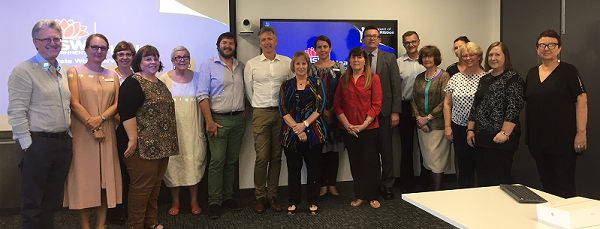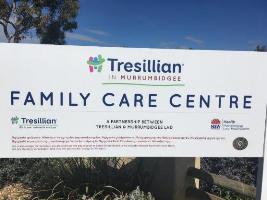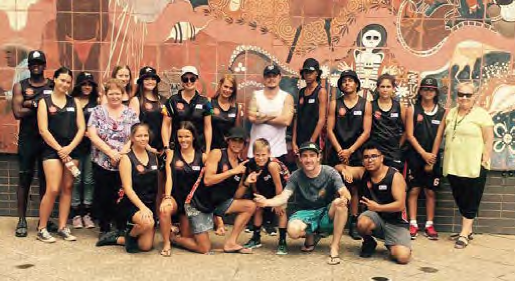Council to visit Murrumbidgee Local Health District
On Wednesday 27 November, Murrumbidgee Local Health District hosted the first Child and Family Health Advisory Council held in a rural LHD. The Council made the successful trip to Wagga Wagga to hear about some of the great initiatives and services that support children and families across the District.
The Murrumbidgee Local Health District put together a varied and very interesting program. The District showcased initiatives that provided the Council with insight into the impact that meaningful partnership, flexibility, commitment to community engagement, and strong leadership can have on improving care.
The Council members are extremely grateful to Jill Ludford, Chief Executive of the Murrumbidgee Local Health District and her team for their time and hospitality. The Council has an important role to play in identifying, reviewing and promoting new and emerging service models and addressing the barriers to system change that affects care for children, young people and families. Members look forward to a visit to Northern NSW Local Health District in 2018. 
A focus on flexibility and partnerships
The visit provided insights into a range of issues faced by services across the state. Council members heard about a range of service developments that have been implemented by the Murrumbidgee Local Health District. There were strong themes of partnership and networking, as well as a clear focus on taking a flexible approach to staff deployment and service use. The re-development of the Wagga Wagga Base Hospital has prompted changes to the paediatric model of care. One example is the establishment of six dedicated short-stay beds, which can also receive patients from the emergency department. This arrangement enables better use of the specialist expertise and creates a much more child friendly environment for families. The District is also reviewing its approach to clinical leadership and networking across services, and to providing care closer to home, including hospital in the home services, for paediatric patients.
Over the last six months, the Wagga Wagga Base Hospital has been one of three sites across the state to take part in the Emergency Department Domestic Violence Screening pilot project, led by the Ministry of Health’s Prevention and Response to Violence Abuse and Neglect Unit. The pilot has been used as an opportunity to improve in-reach support of Wagga Wagga’s Sexual Assault Services and Social Work Services to the Hospital’s emergency department and to enhance the provision of on-call expertise. It is hoped that these changes and the improved pathways will become embedded and will be a lasting outcome from participation in the pilot. More information about the pilot results will be released by the Ministry of Health in early 2018.
In 2017, the District entered into a partnership with Tresillian to deliver

child and family health services for families requiring a level 2 service response. Tresillian employs the service manager, while all other staff are employed by the District. Tresillian has brought to the District their expertise and evidence-based model of care, which aims to improve access and case coordination for families. The partnership is also facilitating local innovation. The service in Wagga Wagga is one of three Tresillian sites to be testing a new Early Intervention Home Visiting model, a twelve week program to develop the capacity of vulnerable parents/carers’ of infants to parent independently.
Benefits from community engagement
“Whatchya gunna do?”
A highlight of the day was the presentation by Leanne Sanders, an Aboriginal Health Promotion Worker about the “Whatchya gunna do?” project. The project’s hip hop video encourages young people to be vaccinated. It was written and performed by a group of Wagga Wagga teenagers after a series of workshops with professional musicians and a local Aboriginal Elder.
Driven by Leanne’s passion and pride, the project recognized the role that music, and a contemporary approach to storytelling, can play in promoting wellbeing.
Leanne was joined by Shanae Pope, one the video’s stars. Shanae spoke very positively about the project and the opportunities for the group to learn about and connect with culture. The YouTube video has received local and state recognition and has had a wide reach across local schools and the communities beyond.
Other presentations also focused on the different approaches to improving community engagement to support access to services for children, young people and families across the District.
The District Child, Youth and Family Health team has released an App to provide information and links for families and professionals about local services and health and wellbeing resources and support. The Council recognises that many similar initiatives, which take significant time and resource to develop, are being implemented across different parts of NSW. The Council will consider how it may be able to advocate for some consistency and efficiency across the system in this area.
Sabrina Brown, Aboriginal Health Coordinator Maternal Child & Family, described a year-long project to create a community space in Nerrandera to deliver the Building Strong Foundations for Aboriginal Children, Families and Communities (BSF) program. By moving out of a clinical setting and into the community, the project aims to improve access, create a more culturally sensitive environment, improve immunisation rates, and support a model of care that allows greater collaboration with mothers and families. The approach provided another example of how advocacy and engagement with communities is a central element to improving outcomes.
The Council Secretariat can be contacted via email HSPB-ICB@doh.health.nsw.gov.au.
Dr Nigel Lyons (Co-Chair)
Dr Andrew McDonald (Co-Chair)
